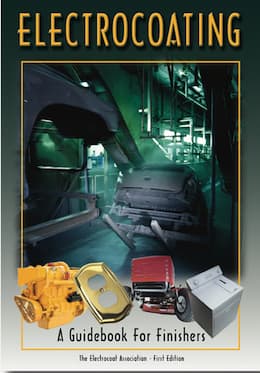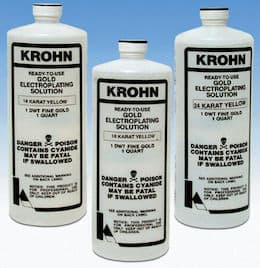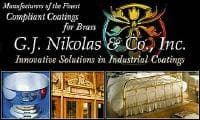
-----
Gold plating & electrophoretic lacquering of costume/imitation jewelry
This meeting place welcomes Q&As, photos, history, & interesting tidbits.
Please engage with other posters
• When people show interest in each other's situations, the page quickly becomes a fun & informative learning experience for everyone !
• When people show no interest in other people's postings, and just post their own, it often quickly deteriorates into a string of unanswered questions 🙂
Q. Respected Sirs ,
I am a metal finishing worker. Recently, I wish to start artificial jewellery selling business.
Sir, after doing copper plating, then nickel plating and then electrophoretic lacquer plating with a well thickness and finally doing PU based clear coating with a well thickness, how much will be the durability of the piece?
Please reply Sir, when you will be free.
Regards,
Suraj Mahal
Metal finishing worker - Kharagpur, west Bengal
April 27, 2024
for Shops, Specifiers, & Engineers

avail from eBay, AbeBooks, or Amazon

avail from eBay, AbeBooks, or Amazon

avail from AbeBooks, or Amazon

avail from eBay, AbeBooks, or Amazon

avail from eBay, AbeBooks, or Amazon
(as an Amazon Associate & eBay Partner, we earn from qualifying purchases)
A. Hi Suraj
It probably depends on what the piece is. If a ring, durability will be terrible; if a pin or a broach durability will probably be excellent. A one piece bracelet or necklace, durability should be fine; a chain-type bracelet probably middling. Electrophoretic lacquer followed by PU is still essentially paint, not metal.
Some years ago finishing.com did a corrosion resistance study comparing electrophoretic lacquers with polyurethane topcoats and other finishes, and the plated finishes won.
Luck & Regards,

Ted Mooney, P.E. RET
Striving to live Aloha
finishing.com - Pine Beach, New Jersey
Ted is available for instant help
or longer-term assistance.
Q. Respected Sirs,
If I guarantee my imitation jewellery products at least for 2 years on daily wearings, what type of clear coat or any other chemical applications, or any other plating method do I have to do?
Sir, Waiting for your valuable suggestions and reply.
With best regards,
Metal finishing worker - Kharagpur, west Bengal
April 28, 2024
⇩ Related postings, oldest first ⇩
Q. I would like to apply the Electrophoretic lacquer coating on my intricate brass pieces which I use as patterns for the castings. So I would like to know the required thickness of the lacquer coating. The thickness of the coating should not affect the dimensions of the cast pieces. And also regarding the hardness and toughness of the coated metal?
Sajeesh [surname deleted for privacy by Editor]imitation jewellery - Mumbai, Maharashtra, India
2005
Q. Hi,
I make jewelry from brass and then I do a 6-step electroplating process: boil in ultrasonic solution, acid wash, heavy copper plating, brightening copper solution, then nickel plating, and finally gold plating with AuCn. After each process the brass is properly washed in tap water, mild solution of H2SO4 and then distilled water in between tanks.
I haven't achieved the quality that lasts as long as I would want.
Can I use anything like lacquer to coat it to keep away moisture and air and still keep the shiny gold finish look?
product designer - Bangkok, Thailand
2007
A. Hi Emeka. There are clear spray lacquers and electrophoretic coatings available, but then your jewelry is no longer 'real'. Gold plating should not tarnish, and it will last in proportion to its thickness, although it may be possible to apply a harder and more wear-resistant gold formulation.

Ted Mooney, P.E.
Striving to live Aloha
finishing.com - Pine Beach, New Jersey
Ted is available for instant help
or longer-term assistance.
(affil links)

free pdf is currently available from academia.edu
Q. . What makes up a more resistant gold solution?
What else do I add to the AuCn solution to maximize durability?
- Bangkok, Thailand
2007
|
A. Emeka, Process Engineer - Syracuse, New York 2007 A. There are alloying metals, such as cobalt, sometimes added to gold to make a harder gold finish. You can get some general information about the formulation of plating solutions from such books as the Metal Finishing Guidebook ⇨  Ted Mooney, P.E. Striving to live Aloha finishing.com - Pine Beach, New Jersey Ted is available for instant help or longer-term assistance. |
Q. I'm Sameer and work in jewellery making.I would like to know how to make perfect plating because I usually use potassium cyanide dissolve in water + 2 batteries of 1.5 v and 2 grams of pure gold to make an anode. My plating is sometimes black. What is my mistake? Does pH play a role in it? Can you tell me what is the perfect ratio of potassium cyanide and water? Thanks.
Sameer H.Mjewellery making - Mauritius
2007
Q. Hi,
I'm a jewelry designer (beginner), and I want to make my jewelry from brass and then gold plating.
I can't use nickel undercoat to get a hard electroplating because I'm exporting my jewelry to Europe where the nickel is forbidden. The company which does the electroplating for me will use first copper then white bronze-like undercoat before the gold.
I will like to use the minimum microns for the gold because my jewelry has a big volume, and the gold is very expensive, but I need a good and resistant quality because my jewelry is destined to high quality fashion customers .
I m thinking of using only 1 micron of gold then an electrophoretic coat ("clearlyte"), but I've just read in this website that the jewelry won't look real anymore. What does that mean? Does it mean that it look like plastic jewelry?
I'm scared of losing the real look of gold and getting a cheap and ugly finishing.
unfortunately, I can't try this product because they don t sell it in Indonesia, and if I order it, I have to buy a minimum quantity (which is huge!) .
The supplier of "Clearlyte" told me that they have only one shiny finish.
Please can you help me, it's very difficult to get this kind of information in Indonesia. Is "Clearlyte" used only for cheap jewelry? How does the finishing look?
Thank you so much in advance for your time.
Yelena
- Bali, Indonesia
February 20, 2008
A. Hi Yelena. Hard gold plating 1 micron thick is quite good quality these days!
We don't compare brands or sources on this site ( huh? why?), but Clearlyte, Protectaclear from Everbrite [a finishing.com supporting advertiser], or anything similar should be fine, although I'm not sure that micron thick hard gold plating really demands a clearcoat -- it depends on how much wear it will get: in my estimation rings get very great wear; watches & bracelets get a lot of wear; necklaces & earrings get less wear; broaches, pins, etc. get very little wear.
Luck & Regards,

Ted Mooney, P.E. RET
Striving to live Aloha
finishing.com - Pine Beach, New Jersey
Ted is available for instant help
or longer-term assistance.
High End Gold Plated Belt Buckle Production
Q. Hi,
I'm looking to start a high-end designer leather belt range and the current belt buckle are made from brass then gold plating.
Nickel is used as an undercoat to get a hard electroplating and stop the brass for migrating before gold plating. The gold plating is done to about 3 microns on the belt buckle.
The question is, how long will it take for a 3 micron gold plate on a belt buckle to wear out (given if it's used every day). I need a good and resistant quality because my belts are destined to high quality fashion customers.
Secondly, do I have to do anything (clear-coat or an extra plating) to the gold plated buckle to give it more rigidity but I wouldn't want to lose the real look of gold on the buckles.
Please can you help me as it has been a challenge for me to get this information.
Thank you so much in advance for your time.
Regards
Chuk
- Bristol, United Kingdom
September 2, 2016
A. Hi Chuk. 3 microns is exceptional quality and should last years in most situations. While it's hard to say exactly what the wear situation is where the prong grinds against the frame, that's the one spot that isn't visible when worn anyway. I would be surprised if you had any trouble or complaints even after many years (remember though, that I'm not a belt designer, and other readers aren't likely to be either).
If the volume were high you could have the buckles PVD coated with TiN before the gold plating. For lower volumes you could apply some sort of clearcoat, but I don't think it's necessary, and it's nice to be able to say your gold plating stands on its own. Good luck.
Regards,

Ted Mooney, P.E. RET
Striving to live Aloha
finishing.com - Pine Beach, New Jersey
Ted is available for instant help
or longer-term assistance.
A. Gold is soft, so I would guess that you need to use something like 10k vs pure gold. A lifetime ago, I had read about "hard " gold. You might want to look into that also.
James Watts- Navarre, Florida
|
Q. Hi, - Bristol, United Kingdom
"Gold Plating Technology"
by Reid & Goldie -- hard to find & expensive; if you see a copy cheap, act fast!  on eBay or Amazon or AbeBooks (affil link) A. Hello Chuck, Ted and James gave excellent info in their comments. A hard acid gold would be the way to go. These gold plating solutions are normally alloyed with nickel or cobalt. As James mentioned you want the gold alloyed to get a 12 or 10 kt finish. You would have to like the colour however. To gain your business, precious metal plating suppliers could plate a few buckles in their lab for you. This way you would know what gold plating bath to use. I am not permitted to name a good supplier on this site but I'm pretty sure they are one of the sponsors. The gold thickness you describe will give you a nice quality product. I have seen clear coats on gold wear away after a few years. Good luck with your new venture! Mark BakerProcess Engineer - Phoenix Arizona A. Hi Chuck  Geoff Smith Hampshire, England Q. Hi - Bristol, United Kingdom September 4, 2016 |
A. Hi again. Gold plating per se does not require baking. Some possible reasons for confusion or contrary opinions, however, could include:
1) the rinsing water must be dried, and often this is done at heat;
2) sometimes plated parts are heated as a QA measure to make sure the plating doesn't blister;
3) some clearcoats are baked for curing.
Some excellent info from Mark Baker and Geoff Smith "crossed in the mail".
Regards,

Ted Mooney, P.E. RET
Striving to live Aloha
finishing.com - Pine Beach, New Jersey
Ted is available for instant help
or longer-term assistance.
A. Hi Chuk. You may have seen a post about hydrogen embrittlement and baking after plating to fix this problem. This is usually only a problem with high strength steel items. We are baking some steel fountain pen components after we gold plate them but we haven't seen this problem with bronze, brass or other metals.
Neil BellAlbuquerque, New Mexico
Q. Hi.
Dear sir, I am a brass buttons manufacturer. It is made from brass metal strips. I am doing acid copper and brass plating; after it, water based lacquer for protective layer. But sir, it is changing colour very quickly. I want minimum one year plating life; my product is very small so cannot hang this goods for electrophoretic lacquer. Please suggest how I can get one year life of plating. I want bright gold colour, but can't do gold plating because cost will be high
Thanks, looking forward for your reply.
Khushi traders - FIROZABAD, Uttar Pradesh, India
June 20, 2018


A. Hi Saurabh. Unfortunately, you haven't told us yet how thick the copper & brass plating layers are, and we don't know what you mean by "changing color very quickly". Is it getting blackened areas which could be cyanide bleedout, or is the lacquer turning yellow, or is the brass losing its shine and becoming dull?
Please send photos of the failing parts next to good parts so we can see the color change. Meanwhile, if we assume the brass is getting dull, I think a water based lacquer is probably not up to the task. Please consider dipping in a dilute sodium benzotriazole ⇦ on eBay or Amazon [affil link] rinse, and then spraying with a solvent based lacquer. Good luck.
Regards,

Ted Mooney, P.E. RET
Striving to live Aloha
finishing.com - Pine Beach, New Jersey
Ted is available for instant help
or longer-term assistance.
Q. Hi..
Thank you dear sir for your reply. Actually sir I want to do electrophoretic lacquer dye gold for very good results but my product is very small as 3mm, 4mm, 6mm and quantity is 200kg every day. So cannot hang every piece for electric currant, please suggest me which kind of plating method or which kind of equipment we can do electrophoretic lacquer dye gold on very small parts. I want one year life of plating.
- FIROZABAD, Uttar Pradesh India
Q. Hello Everyone. Jewelry making is my passion. Problem which I am facing is how can I seal copper jewelry? I handcraft them, need suggestion. Currently in India.
The normal lacquer spray will wear off within a month. Also after polishing, what should I do. How to coat or finish it. I need to sell them but want to give customers quality & satisfaction. Really confused.
Poornima Sharma- Delhi, New Delhi, India
June 7, 2018
Q. I am an imitation jewelry craftsman. I have trouble finding a gold color substitute other than using a layer of pure gold. Are there other ways beside using gold base material?
Ilham FiqriPlating - Indonesia
August 24, 2018
A. Hi Ilham. The most convincing alternative is probably titanium nitride coatings applied in a PVD chamber, but the capital cost is probably out of reach for craftsmen. A gold colored CED coating is possible but is only generally somewhat gold colored; no one would mistake it for gold plating. In thread 37526 Geoff Smith tells us about some alloys intended to look like gold including Pinchbeck Alloy, Dutch Metal, and Nordic Gold.
Regards,

Ted Mooney, P.E. RET
Striving to live Aloha
finishing.com - Pine Beach, New Jersey
Ted is available for instant help
or longer-term assistance.
Q, A, or Comment on THIS thread -or- Start a NEW Thread



